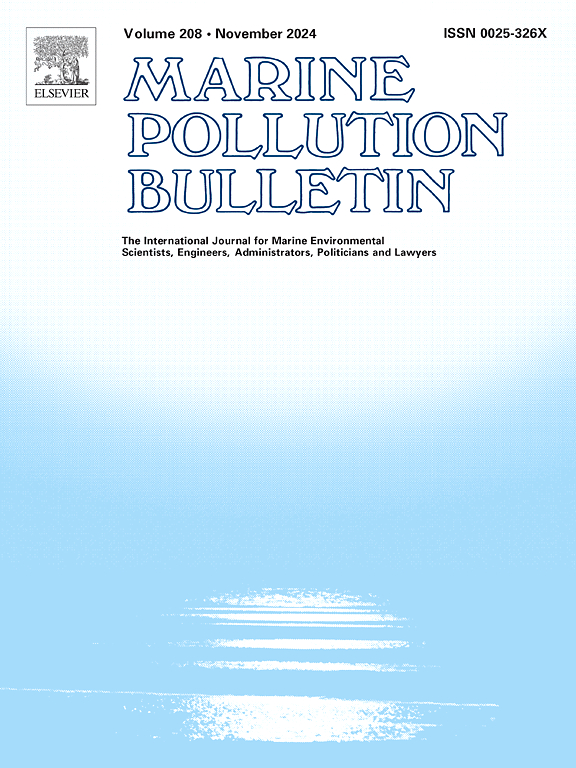阿尔及利亚海岸(西地中海)拖网捕鱼区海底大型凋落物的分布和组成。
IF 5.3
3区 环境科学与生态学
Q1 ENVIRONMENTAL SCIENCES
引用次数: 0
摘要
在分别于 2016 年、2019 年、2021 年和 2022 年进行的四次底栖资源评估研究航行期间,我们在贝尔卡姆号研究船(R/V)上使用 GOC73 底拖网共进行了 254 次捕捞取样。我们在水深 22 米至 660 米之间进行了拖网作业,之后对每件海洋垃圾进行了单独计数和称重(精确到 0.5 克)。结果显示,海洋垃圾密度介于 1350 至 5813 件/平方公里之间。因此,塑料是数量最多的垃圾,平均占整个海洋垃圾的 76%。在这些塑料中,3.8%被确认为渔具或与捕鱼有关的物品。因此,在研究期间,平均渔获量损失估计为 7%。然而,位于阿尔及利亚海岸中部的贝贾亚地区海洋垃圾密度最高。此外,水深和地理差异对海洋垃圾的密度和重量都有显著影响。为了提供更有效的解决方案,有必要实施海洋垃圾监测计划。本文章由计算机程序翻译,如有差异,请以英文原文为准。
Distribution and composition of seafloor macrolitter in the trawlable fishing areas along the Algerian coast (Western Mediterranean)
A total of 254 fishing hauls were sampled with a GOC73 bottom trawl during the four demersal resource assessment research cruises, respectively, in 2016, 2019, 2021 and 2022, carried out on board the BELKACEM GRINE research vessel (R/V). We performed the hauls between 22 and 660 m of depth, after which we counted and weighed each piece of marine litter separately to the nearest 0.5 g.
The results show that marine litter densities varied between 1350 and 5813 item/km2. Thus, plastic is the most abundant litter, it represents a mean rate of 76 % of the whole marine litter. Among this plastic, 3.8 % was identified as fishing gears or fishing related objects. Therefore, the average loss in catch was estimated at 7 % over the study period. However, the highest density of marine litter was found in the region of Bejaia located in the Center part of the Algerian coast. Moreover, the bathymetric and geographical variability had a significant impact on both density and weight of marine litter. A marine litter monitoring program is necessary for offering a more effective solutions.
求助全文
通过发布文献求助,成功后即可免费获取论文全文。
去求助
来源期刊

Marine pollution bulletin
环境科学-海洋与淡水生物学
CiteScore
10.20
自引率
15.50%
发文量
1077
审稿时长
68 days
期刊介绍:
Marine Pollution Bulletin is concerned with the rational use of maritime and marine resources in estuaries, the seas and oceans, as well as with documenting marine pollution and introducing new forms of measurement and analysis. A wide range of topics are discussed as news, comment, reviews and research reports, not only on effluent disposal and pollution control, but also on the management, economic aspects and protection of the marine environment in general.
 求助内容:
求助内容: 应助结果提醒方式:
应助结果提醒方式:


